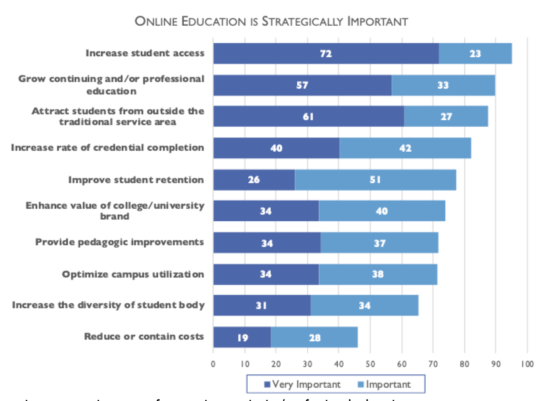
In the first four posts in this series I looked at the following possible reasons for online learning:
- Ontario’s strategy to use online learning to ease pressure on high schools
- using online learning to reduce the cost of higher education
- using online education to support disadvantaged students: no online learner left behind
- developing skills for a digital society
In this post I want to set priorities, but before doing that, I need to add a couple of other purposes which I took for granted. Indeed I should have started with these.
Current institutional priorities for online learning
Thanks to the annual national survey of online learning in Canadian post-secondary education, we actually know the priorities of institutions for online learning. In the 2018 survey, which covered the academic year 2016-2017, institutional leaders responded as follows:

Source: Bates et al. (2018) Tracking Online and Digital Education in Canadian Universities and Colleges: 2018 Halifax NS: CDLRA
The most important reason for online learning for most institutions was to increase student access, with 95% of institutions rating it as either important (23%) or very important (72%). Closely linked in second place was the opportunity to access students from outside the regular catchment area (88%).
This is no surprise: student access and flexibility have always been a priority for online learning, bringing in new students, and enabling students with part-time or full time responsibilities in work and/or family to pursue their studies.
Also rated as important (82%) was to increase the rate of credential completion, presumably by allowing students to take courses online that would not otherwise be available on campus because numbers were capped or courses were not offered on campus in some semesters. A high proportion of institutions (77%) also rated student retention highly. I interpret this to mean that although completion rates for individual courses may be slightly lower for online than campus-based courses, the flexibility they provide allow more students to complete overall.
Getting down the list we see the value of online learning for ‘providing pedagogic improvements’ (71%), a pretty general category that might include developing skills for a digital society.
Ranked at the very bottom of reasons offered to institutions was to reduce or contain costs, but even here 47% of institutions ranked this as important.
It is important though to remember that this question asked for opinions. Although the survey went to institutional leaders, such as Provosts, it is probably answered by several different people in the same institution. Knowing their opinions is valuable, but it’s not quite the same as identifying actual priorities in terms of resource allocation, for instance.
My priorities
There is of course no reason why online learning could not serve many different purposes equally well. However, a jack of all trades is a master of none. Implied within each priority are decisions about strategies and resource allocation. It helps to be clear on your priorities. So here is my personal ranking:
- increasing access and flexibility
- developing 21st century skills
- reducing inequalities in the education system
- increasing the cost-effectiveness of education
If you don’t get students into post-secondary education, you can’t meet any of the other priorities, so access and flexibility are still the most important.
However, it’s no good getting students into education if you don’t do the important stuff, and for me, preparing our students for what I fear may be a very dangerous and unhappy future if people as individuals have no control over technology. This is a huge challenge for educational institutions, requiring major curricular and teaching changes. However, digital learning should be an essential part of the solution. This is almost as great a priority as increasing access.
I also think we could do a better job helping that minority of students who really struggle with online learning, who are often the most disadvantaged in our society, either through special programs or extra support.
Lastly, yes, we should always be looking at ways of making education more affordable without losing quality. However, while I believe online learning could bring about some improvements in cost-efficiency, it will be both hard work and the savings will not be so great as to significantly reduce the cost, without losing quality. I would rather reallocate within online learning to use efficiencies to pay for extra support for disadvantaged students taking online learning.
Over to you
Now it’s your turn. I’d love to hear from you on this topic:
- Do you think we need to rethink the priorities for online learning, or have we got it right?
- Should we give more priority to digital learning and less to traditional teaching in the future? (I hope this blog goes beyond the true believers!).
- Within online or blended learning, should we be more ambitious in our pedagogical roles, taking on the challenge of preparing students for an increasingly digital society – or should we still focus on turning out academic researchers, doctors, chemists, philosophers, historians who are more subject-focused?
- Does digital learning offer affordances in teaching soft skills that are not available from classroom teaching? Or is there something ‘special’ about digital learning for teaching soft skills? If so, what?
Please use the comment box below (although a postcard is always nice).









 Dr. Tony Bates is the author of eleven books in the field of online learning and distance education. He has provided consulting services specializing in training in the planning and management of online learning and distance education, working with over 40 organizations in 25 countries. Tony is a Research Associate with Contact North | Contact Nord, Ontario’s Distance Education & Training Network.
Dr. Tony Bates is the author of eleven books in the field of online learning and distance education. He has provided consulting services specializing in training in the planning and management of online learning and distance education, working with over 40 organizations in 25 countries. Tony is a Research Associate with Contact North | Contact Nord, Ontario’s Distance Education & Training Network.


Hi Tony,
My question is how do you lose quality in online education based on affordability? I am currently teaching in college and we are being pushed to develop more and more online courses, or move our courses to some form of hybrid course. I was under the impression that online courses were very lucrative as there is 1 prof teaching it and the fee per student is lets say $1500. I think if you have a small class this may become expensive but if you have 20+ students i thought it would be financial lucrative. I agree that with any excess funds, there should be allocation to students that require additional support or support the educators who have an increased load d/t having more of these students in the class.